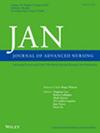Insights and Perceptions of Gender Discrimination in a Woman-Dominated Profession: A Cross-Sectional Study of Women in Nursing.
IF 3.4
3区 医学
Q1 NURSING
引用次数: 0
Abstract
AIM The overarching aim was to explore women registered nurses' perceptions of gender discrimination in the workplace. DESIGN A descriptive cross-sectional exploratory survey within a sequential explanatory mixed methods study. METHODS Between September and December 2023, data were collected from 173 registered nurses who self-identified as women. The survey captured demographic data, attitudes to gender discrimination in society using the 'Contemporary Gender Discrimination Attitude Scale' and perceptions of workplace gender discrimination in nursing across four dimensions, assessed using the 'Perception of Workplace Gender Discrimination for Women Nurses Scale' (PWGD-WN). Descriptive statistics presented as means and standard deviations were used to describe and interpret data. Regression analysis and chi-square tests were employed to examine associations between key variables. RESULTS The mean score on the Contemporary Gender Discrimination Attitude Scale was 4.56 (on a 6-point scale), indicating that on average respondents agreed that gender discrimination remains an issue in society. The PWGD-WN scale mean scores for the dimensions of gender discrimination (5-point scale) from lowest to highest were: 'Gender bias from other women' (Mean: 3.13, SD: 1.147), 'Interpersonal discrimination' (Mean: 3.30, SD: 1.135), 'Glass escalator' (Mean: 3.77, SD: 0.946) and 'Primary carer' (Mean: 3.86, SD: 0.796); higher scores indicated agreement with items. 'Primary carer' was the strongest predictor of attitude, followed by the 'Glass escalator'. Highest qualification obtained was highlighted as a key predictor of nurses' perceptions of workplace discrimination. CONCLUSION The results of this study highlight that women in nursing perceive that systemic and multidimensional discrimination exists in the workplace. IMPLICATIONS FOR THE PROFESSION The results can be utilised to understand how discrimination manifests in the workplace for women in a woman-dominated profession. IMPACT This research provides the first quantitative measure of perceived workplace gender discrimination for Australian women registered nurses. REPORTING METHOD We have adhered to relevant EQUATOR guidelines-STROBE. PATIENT OR PUBLIC CONTRIBUTION This study did not include patient or public involvement in its design, conduct or reporting.女性主导职业中性别歧视的洞察和认知:护理女性的横断面研究。
目的:主要目的是探讨女性注册护士对工作场所性别歧视的看法。设计在顺序解释混合方法研究中进行描述性横断面探索性调查。方法于2023年9月至12月对173名自称为女性的注册护士进行数据收集。该调查利用“当代性别歧视态度量表”收集了人口统计数据、社会对性别歧视的态度,并利用“女护士工作场所性别歧视感知量表”(PWGD-WN)评估了四个维度对护理工作场所性别歧视的看法。描述性统计采用均值和标准差来描述和解释数据。采用回归分析和卡方检验检验关键变量之间的相关性。结果“当代性别歧视态度量表”的平均得分为4.56分(总分为6分),表明受访者普遍认为性别歧视仍然是一个社会问题。PWGD-WN量表的性别歧视维度(5分制)从低到高的平均得分为:“来自其他女性的性别偏见”(均值:3.13,SD: 1.147)、“人际歧视”(均值:3.30,SD: 1.135)、“玻璃自动扶梯”(均值:3.77,SD: 0.946)和“主要照顾者”(均值:3.86,SD: 0.796);分数越高,表示对题目的理解越一致。“主要照顾者”最能预测态度,其次是“玻璃自动扶梯”。获得的最高资格被强调为护士对工作场所歧视看法的关键预测因素。结论本研究结果表明,护理女性认为工作场所存在系统性和多维度的歧视。对职业的影响研究结果可以用来理解在女性主导的职业中,歧视是如何在工作场所表现出来的。影响本研究提供了澳大利亚女性注册护士感知工作场所性别歧视的第一个定量测量。报告方法我们遵循赤道相关指南- strobe。患者或公众的贡献本研究的设计、实施或报告中没有患者或公众的参与。
本文章由计算机程序翻译,如有差异,请以英文原文为准。
求助全文
约1分钟内获得全文
求助全文
来源期刊
CiteScore
6.40
自引率
7.90%
发文量
369
审稿时长
3 months
期刊介绍:
The Journal of Advanced Nursing (JAN) contributes to the advancement of evidence-based nursing, midwifery and healthcare by disseminating high quality research and scholarship of contemporary relevance and with potential to advance knowledge for practice, education, management or policy.
All JAN papers are required to have a sound scientific, evidential, theoretical or philosophical base and to be critical, questioning and scholarly in approach. As an international journal, JAN promotes diversity of research and scholarship in terms of culture, paradigm and healthcare context. For JAN’s worldwide readership, authors are expected to make clear the wider international relevance of their work and to demonstrate sensitivity to cultural considerations and differences.

 求助内容:
求助内容: 应助结果提醒方式:
应助结果提醒方式:


